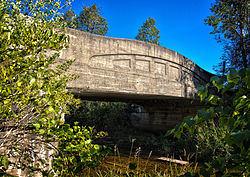Ocqueoc River
| Ocqueoc River | |
|---|---|

River Road over the Ocqueoc River.
|
|
| Country | United States |
| Basin features | |
| Main source | Bismarck Township, Presque Isle County, Michigan |
| River mouth |
Lake Huron at Ocqueoc Township, Presque Isle County, Michigan 584 feet (178 m) |
| Basin size | 94,394 acres (382.00 km2) |
| Tributaries |
|
| Physical characteristics | |
| Length | 34 miles (55 km) |
The Ocqueoc River (pronounced Ah-key-ock) is stream in Presque Isle County in the northeastern part of the lower peninsula in the U.S. state of Michigan. It is 34.2 miles (55.0 km) long and encompasses a watershed of approximately 94,394 acres (382.00 km2).
The word Ocqueoc comes from a French term meaning "crooked waters", which aptly describes the winding Ocqueoc River.
The Ocqueoc River is the largest river entirely within Presque Isle County and drains several lakes, including Ocqueoc Lake, and receives a few tributaries, the largest being the Little Ocqueoc River and Silver Creek. The Ocqueoc River's source is in southern Bismarck Township at 45°13′15″N 83°55′45″W / 45.22083°N 83.92917°W approximately 10 miles (16 km) southeast of the village of Millersburg, which with a population 263 people at the 2000 Census is the largest community in the watershed.
Ocqueoc Falls are the largest waterfalls in the Lower Peninsula of Michigan with a drop of about 5 feet (1.5 m). The falls and the Ocqueoc Falls Bicentennial Pathway, which offers groomed winter trails and summer hiking trails, are a tourist attraction of Presque Isle County. The Ocqueoc River is one of the few rivers in the Lower Peninsula to flow north.
The Ocqueoc River flows through a limestone karst region, and some of its tributaries, notably the Little Ocqueoc, are not continuous on the surface but flow through subterranean systems for part of their course. The upper reaches of the river's watershed is swampy with cedar, tamarack, balsam, poplar, aspen and black ash common. The warmer upper ranges have more warm-water fish including sunfish, pike and bass, while the lower cooler part of the river has salmon and trout.Smelt dipping is a style of fishing used near the mouth of the Ocqueoc.
...
Wikipedia
